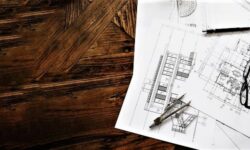Advice: Stop Relying Solely on Floor Plans and Start Taking Pictures
Shane Clary presents real-world examples of how pictures and site visits can fill in the details that floor plans may miss during systems design.

As part of my regular job, I look at a lot of building plans and visit building sites, both existing and under construction. Depending on the plans provided, the designer of a system may or may not be able to ascertain a correct picture of the ceiling or ceiling/roof assembly geometry.
Take the three photographs, shown below, from recent projects. All three locations are buildings under construction for tenant improvement. For all three, plans were available for review and use for the development of the shop drawings.
If the designer of these three systems only looked at the basic floor plans, they could have determined that all locations had smooth, flat ceilings that were less than 10 feet high. As you can see, this was far from the reality.
Details from ceiling plans, structural plans and elevations were all required to produce the true picture of how the room spaces would be at completion.
Fortunately in all of these cases, I had a good set of building plans. There are too many instances, however, in which good plans — or any plans for that matter — are not available.
A site visit, if possible, needs to be performed. At some point a set of plans will need to be developed, but photos taken during the bid and predesign phase of a project help immensely. During my career I’ve snapped well over 20,000 photos of projects I was working on.
Before the advent of digital photography, these pictures were on film, which limited the amount that could be taken. And then there was the wait of having the photos developed, hoping that they were in focus, exposed correctly and provided enough details.
With digital cameras, smartphones and tablets — all of which take superb images these days — I might now take 100+ pictures in one site visit. Photos also help if you cannot get to the site but the sales representative is there and has questions — in this case a picture may really be worth a thousand words.
One can also use Google Earth to view a building from above and in most cases, see the building from street level. While this will not get you inside, it at least gives a glimpse of the basic building construction. If the building has yet to be constructed, then you must depend on the drawings provided.
There’s no reason why the designer of a fire alarm system should not be provided the full set of building plans, similar to any other trade that may be on the project. In this case, the system is created as per the design of the building. Once construction is in the late framing stages, a site visit should still take place.
There have been times I’ve missed a few points on the drawings, even when all of the plans were provided, that a quick visit to the building during construction corrected.

Never make system design assumptions based solely on plans and drawings; site visits where these photos were taken revealed (l-r) things like ceiling surface discrepancies; a crane system that changed where a detector could be placed; and a challenging angled/sloped environment.
In the first photo, the ceiling/roof assembly is about 25 feet above the finished floor. If one looked at just the floor plan, it could have been assumed the ceiling was smooth and flat; that wasn’t so.
After looking at the ceiling plan and elevation drawings, it was determined that a smoke beam be installed in the center, with several spot type smoke detectors installed on the sides where the smoke beam wouldn’t cover.
Photo two shows a former aircraft hangar. The plans indicated that the ceiling was very high, and that if ceiling horn/strobes were to be used, they would need to be dropped down to 30 feet to be in compliance with NFPA 72. What wasn’t indicated on the plans was the crane system that can travel the length of the structure … this required the notification appliance be installed on the side walls instead.
The third picture is a space in which smoke detection is being installed and whose ceiling has various angles and slope. The floor plans would have led one to think that this was a simple ceiling, but the roof framing plans told a different story. In the end, four detectors were required in this one space.
If you enjoyed this article and want to receive more valuable industry content like this, click here to sign up for our FREE digital newsletters!

Security Is Our Business, Too
For professionals who recommend, buy and install all types of electronic security equipment, a free subscription to Commercial Integrator + Security Sales & Integration is like having a consultant on call. You’ll find an ideal balance of technology and business coverage, with installation tips and techniques for products and updates on how to add to your bottom line.
A FREE subscription to the top resource for security and integration industry will prove to be invaluable.















This article is full of common sense, good documentation saves time and money. As important as this is to state, you almost wonder if it should take an article to remind people to document their projects.
While making sure you are bidding the project correctly, it is every bit as important to create documentation for the techs doing the work. One of our larger dealers had an employee meeting and every tech wanted better notes, followed by more pictures. They just started using our software and the techs like it more than the sales people, still, the sales people like it a lot because it makes their job easier. Attaching images/comments directly to the location and system (security, access control, etc) as the project is walked will save confusion and that “What do you want in this location” phone call. Try having techs send pictures back to sales to markup then send back, saves trips out to jobsite. While we automatically save those pictures in our software, for more manual systems create a process saving all pictures in the job file using something like dropbox. Just keep clicking pictures, there are never too many images of a project.